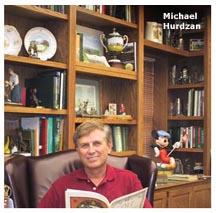Good news often is a matter of perspective.
As industry analysts throw around terms like market correction to rationalize the shrinking supply of golf courses nationwide, there still are some who prefer to think that the game would benefit from more players, not fewer properties.
"We dont have too many courses; we need more golfers," said golf course architect Michael Hurdzan, Ph.D. "When a golf course closes weve lost an opportunity to bring someone new into the game. Weve lost a chance to reach out and touch someone."
 While Hurdzan's call to introduce more players to the game rather than cede more golf course acreage to the plow might seem like an obvious philosophy. But the fact is while the golf market is self correcting or at least while industry insiders continue to look for ways to promote the game to new and existing players, golf course architects are, to put it simply, taking it in the shorts. Operations that once boasted of plenty of work and staff members to handle the flurry of activity have been reduced to shells of their former selves. According to the American Society of Golf Course Architects, the number of practicing golf course designers is down 10 percent to 15 percent over the past 10 or so years to about 180 members (ASGCA estimates there could be another 200 or so designers who are non-members) as new course construction projects have all but dried up and the competition for restoration projects intensifies.
While Hurdzan's call to introduce more players to the game rather than cede more golf course acreage to the plow might seem like an obvious philosophy. But the fact is while the golf market is self correcting or at least while industry insiders continue to look for ways to promote the game to new and existing players, golf course architects are, to put it simply, taking it in the shorts. Operations that once boasted of plenty of work and staff members to handle the flurry of activity have been reduced to shells of their former selves. According to the American Society of Golf Course Architects, the number of practicing golf course designers is down 10 percent to 15 percent over the past 10 or so years to about 180 members (ASGCA estimates there could be another 200 or so designers who are non-members) as new course construction projects have all but dried up and the competition for restoration projects intensifies.
"I'd say, 60 to 70 percent of the people who once worked in this industry are gone," said architect John Fought. "The architects might be there, but the support staff is gone and business now might be down to one or two people and is being run out of the house instead of an office."
For example, the firm of Hurdzan Fry Environmental Golf Design has produced some of the world's most highly acclaimed minimalist properties, including Erin Hills in Wisconsin, which has been tapped as the site of the 2017 U.S. Open. Earlier this year, however, the team split off into two factions Hurdzan Design and Fry/Straka Global Golf Course Design. Hurdzan, who expressed little interest in the commitment necessary to build a brand overseas, said he will focus on domestic restoration projects, while the team of Dana Fry and Jason Straka will concentrate on foreign construction projects. Still, much of the decision to split the company was due to economics, Hurdzan said. The two companies will work together on some projects, but the difference now is each picks up his own end of the business expenses.
Hurdzan Fry once employed a staff of 10 and spent $120,000 annually in healthcare costs alone. That model was unsustainable in the current economy. Eliminating nearly all of those expenses has been a necessity for many if not all architectural firms.
"These decisions are now being driven by taxes and healthcare costs," Hurdzan said. "It's causing us to cut back. We can do less work and survive doing it at a lower number. There are people in this business living on credit cards and retirement funds just to save face and continue to operate in the business.
"Right now is not a good time to be a golf course architect."
Prior to 2006, golf courses openings outpaced closures every year since the end of World War II. Since 2006, however, a total of 442 courses have been built while 782 have been shuttered for a net loss of 340 18-hole equivalents. The number of new course openings has declined each year, from 119.5 in 2006 to 30 last year. Although the official numbers for 2012 wont be released until some time next year, some architects have said the anticipated number of 18-hole equivalents opening this year could be 10 or fewer.
 So, while the chances of landing a new construction gig are practically nil, the competition for restoration projects intensifies. To make matters worse, the stagnant economy coupled with increased competition for work means that the fees generated by restoration projects is a fraction of what it was 10 years ago.
So, while the chances of landing a new construction gig are practically nil, the competition for restoration projects intensifies. To make matters worse, the stagnant economy coupled with increased competition for work means that the fees generated by restoration projects is a fraction of what it was 10 years ago.
Fought says any golf course designer worth his salt will charge a fee that is about 10 percent of the cost of construction. Some, however, will do the work for less and some will try to get more, and then there are those, he says, who will almost give away their services just to get some work.
Fought is a fan of classic-era, minimalist architecture. However, he says architects can only go so low before the integrity of the golf course suffers. Then everyone involved, architect, owner, superintendent, club pro and customer, loses.
"We love to build player-friendly golf courses with aesthetic value, but if you build one too player friendly, then you might drive away all of your customers," Fought said. "Building a golf course is a lot like buying a car. There are certain things youre always going to want. When you buy a car, you still want electric windows. You just want to pay as little as possible for them. So, do you want a super expensive course that is too long and too hard with 20-foot deep bunkers that you cant afford to maintain, or do you want classic architecture with few bunkers, but that is still strategic and fun to play?"
Architects are meeting these economic challenges in different ways. Some focus entirely on restoration projects or have drilled down to even more specific niche areas, such as focusing on sustainable design, restoring properties that are being prepped for resale, or shifting the bulk of their operations to a more lucrative Asian market. But even the latter has its drawbacks as the government in Beijing has put a halt on new course construction amid growing concerns over the environmental impact of building too many courses too quickly.
While Hurdzan and the team of Fry and Straka will partner on some projects, they will do so as separate entities. Rather than employ 10 people, Hurdzan now has a staff of three that includes himself and son, Chris.
Jim Engh, whose resume includes The Club at Black Rock in Coeur DAlene, Idaho, is focusing much of his attention on what, for some, has been a lucrative overseas market. He also already has the experience needed at working with people from other cultures that Hurdzan and others say is invaluable when tapping into those markets.
The Jim Engh Design Web site has links for information in Spanish and Chinese, and his inaugural design project was Dragon Hills Club in Thailand. But even the Asian market is tightening thanks to a halt on new construction in China and increased competition as other architects head overseas to escape the U.S. golf economy.
"It takes a long time to nurture those relationships. You dont walk in and get a deal," Engh said. "And you dont walk in with a contract in your hand, you go in with a gift."
Some architects also fear that architects from the West might be deemed obsolete when Chinese, South Korean or Vietnamese nationals aspiring to a career in golf course design learn enough to do the work themselves.
Like Hurdzan, Fought, whose resume includes Pumpkin Ridge in Cornelius, Ore. (which he designed with Bob Cupp in 1991) and a restoration of Pine Needles in Southern Pines, N.C., has shunned the foreign markets. He once focused about half of his efforts on restoration projects. Now, renovations are his firms lifeblood because there are so many uncertainties when working in foreign countries, he said.
"I love designing golf courses. Its the best job in the world," he said. "But I dont want to live in the Far East. Thats not why I got into this.
"Foreign entities, its just so hard to figure out. You dont work with contracts. Its just not what I want to do."
Nowadays, he focuses not only on restoring golf courses, but making them more manageable for superintendents and their budgets. That can be accomplished through a variety of methods, Fought said, including wider landing areas, maintenance friendly bunkers and rebuilding areas with poor drainage.
"By rebuilding, you can actually help a golf course save money," Fought said. "The superintendent spends less time and resources repairing areas than he did before. That is what the market is telling us to do."
He cited an example of a recent restoration in which he replaced steep-faced bunkers with hazards more in line with what the original designer had in mind when he built the course during the classic era.
"Now, when they have a major rainstorm, a couple of guys can have all the bunkers fixed in a couple of hours," Fought said. "Before, it would take the whole crew a couple of days to fix them. Then they couldnt mow, or do other things. Just by rebuilding the bunkers it changed the whole dynamic of the golf course, and the superintendent is spending maintenance dollars on the right things instead of spending time and money on things that wouldnt go away."
 Steve Smyers, whose design in Zionsville, Ind., Wolf Run Golf Club, is No. 62 on Golfweek's Best list of Top 100 Modern golf courses, has found an even more specialized niche in preparing financially distressed properties for sale. While devoted to the restoration of financially stable properties, reworking those that are troubled is an admirable feat that is bent on keeping them as golf courses rather than strip malls.
Steve Smyers, whose design in Zionsville, Ind., Wolf Run Golf Club, is No. 62 on Golfweek's Best list of Top 100 Modern golf courses, has found an even more specialized niche in preparing financially distressed properties for sale. While devoted to the restoration of financially stable properties, reworking those that are troubled is an admirable feat that is bent on keeping them as golf courses rather than strip malls.
"None of us are as busy as we'd like to be," Smyers said. "Golf course architects are the first to feel the downturn in the economy, and were the first to feel the upswing."
When the upswing will occur, if ever, is anyone's guess. But many architects agree that for them at least, that rebound in the United States anyway isnt coming any time soon.
"In the U.S., until building housing en masse starts again I don't see a lot happening for a while," Engh said. "Were fully committed to Asia at this point."
Recently, Golf Datatech, a Florida-based firm that tracks business trends in golf, indicated that rounds played through September 2012 had increased at what could be a record pace, at least a record pace since Datatech began tracking such figures 13 years ago. Much of the increase in rounds played is attributed to weather anomalies throughout much of 2012 that resulted in virtually an absence of winter conditions and prolonged warmth throughout the fall in much of the country. Severely discounted green fees havent hurt either.
Hurdzan told of a golf course that opened six years ago with $90 green fees, and now charges $29, which includes range balls, lunch and two cups of beer. When revenue falls, it often is the superintendent's budget where further cuts are made.
"There is no way in hell you can make it in that market," Hurdzan said. "I dont care how many rounds you run through it, youre going to wear out the golf course.
"I think its too easy to say this is just a correction of the market. I attend a number of annual summits. At one, I was at a board meeting and I asked how many people around this table have paid for a round of golf in three years. No one raised their hand. Its funny, but I think some of the people who are decision makers in this industry are out of touch."
There are some who believe that an increasing number of people who believe golf is just too difficult, too expensive and takes too long to play.
"The game has to change fundamentally," Hurdzan added. "People wont spend five or six hours for a round of golf. I think change is going to be slow, but we have to reinvent some of these golf courses. We need to stimulate interest in the game. I dont have the answers, but if we get creative people in this industry to think about it, well find an answer."
Smyers, on the other hand, believes advancements in technology have made the game easier than ever. He also recognizes that it might take some radical thinking to get more people into the game and get existing golfers to play more so he and other architects can get busy again.
"I'm not one to fall down on the side that it takes too long or is too hard," Smyers said. "Its probably easier now to play than ever. We used to play with rickety golf balls and persimmon drivers hit off dirt for a tee. And fairways were mowed once or twice a week at an inch. Now, then it was extremely hard to get around a golf course. But, whatever we can do to make the game more enticing, the better we all will be."
Engh believes some compromises will have to be made if the U.S. golf course construction and restoration market is going to rebound.
"The big money is not there. There is a niche out there to build golf courses that win awards and to do it on budgets that are exponentially less than what they once were," Engh said. "But construction budgets will have to come down even more, and so will some expectations. That might mean no cart paths, but then you wear out spots on the fairways. The maintenance budgets to maintain courses the way owners want them built just is not there. We can still build good golf courses, but were going to have to cut out on some of the niceties and cut back on the maintenance. If golf does have a future, I think that's it."

